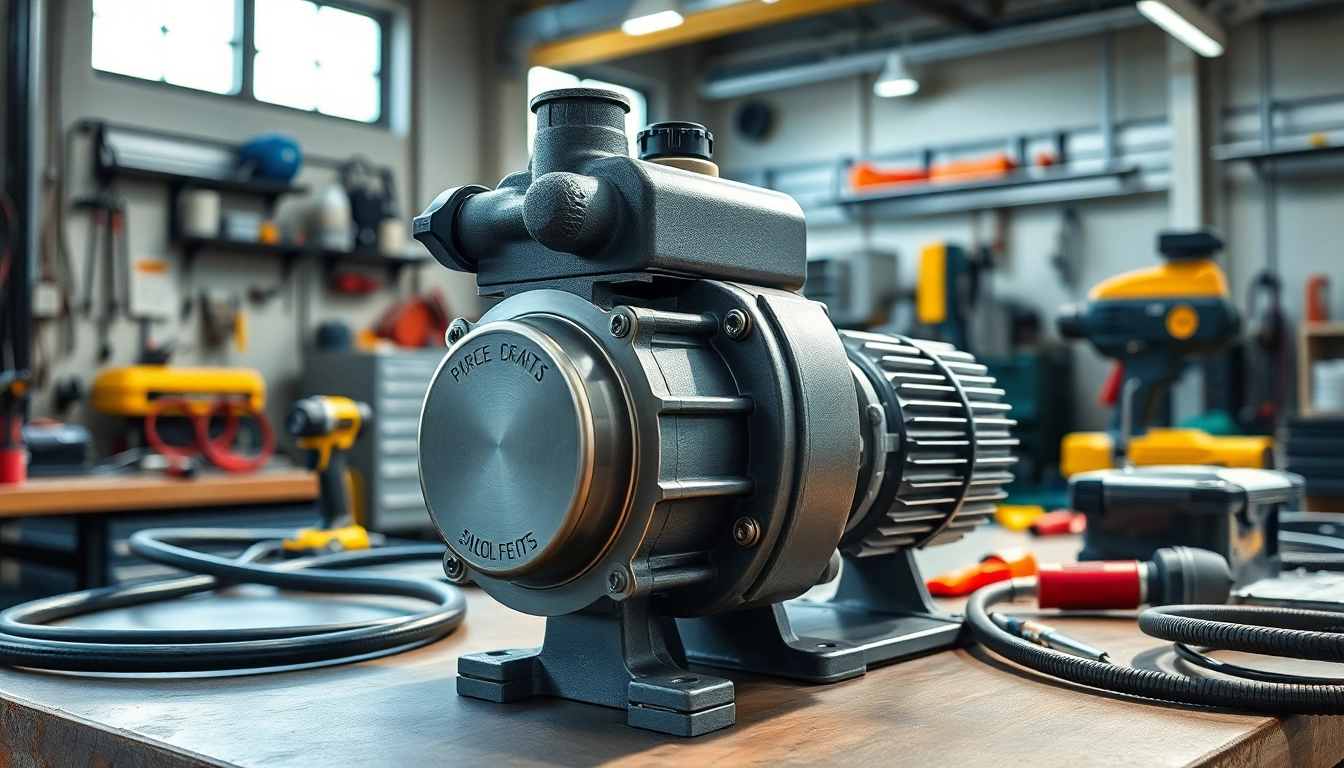1. Introduction to Pneumatic Vacuum Pumps
Pneumatic vacuum pumps are devices that employ compressed air to generate suction, creating a vacuum that can be used across various applications. Utilizing fundamental principles of fluid dynamics, these pumps are increasingly popular due to their efficiency, reliability, and versatility. From industrial automation to laboratory environments, understanding how pneumatic vacuum pumps function can provide insights into their benefits and applications. Moreover, exploring the pneumatic vacuum pump landscape reveals significant advancements in technology, making them ideal for diverse operations.
What is a Pneumatic Vacuum Pump?
A pneumatic vacuum pump is a device that creates a void space by extracting air from a defined volume, typically using compressed air as its primary energy source. The suction created facilitates processes such as picking and placing materials, filtering, and even transporting fluids. These pumps are distinguished from electric vacuum pumps, as they do not require electrical power, making them suitable for environments where electrical connections may be problematic.
Key Components and Functionality
The functionality of pneumatic vacuum pumps relies on several core components:
- Compressor: This component generates compressed air which serves as the driving force of the pump.
- Vacuum chamber: A sealed area where the air is evacuated to create a vacuum.
- Vacuum switch: Monitors the pressure inside the system, ensuring efficient operation by activating or deactivating the pump as needed.
- Diffuser: Helps convert kinetic energy into pressure energy, enhancing the suction capability.
- Exhaust port: Allows the expulsion of air after the suction process.
Understanding these components is crucial, as it provides insights into how pneumatic vacuum pumps can vary in design and performance metrics depending on specific applications.
How Pneumatic Vacuum Pumps Compare to Other Types
When compared to electric vacuum pumps, pneumatic vacuum pumps offer distinct advantages, particularly in environments where electricity is not feasible or safe. Some key differences include:
- Energy Source: Pneumatic vacuum pumps utilize compressed air, while electric pumps require electrical inputs.
- Ease of Maintenance: Pneumatic systems generally have fewer moving parts, resulting in lower maintenance needs compared to their electrical counterparts.
- Safety Considerations: In hazardous environments, pneumatic pumps can be safer due to the absence of electrical sparks.
These comparisons help professionals make informed decisions about which type of pump best suits their operational needs.
2. Working Principles of Pneumatic Vacuum Pumps
The Bernoulli Principle Explained
The Bernoulli Principle is foundational to understanding the operation of pneumatic vacuum pumps. It states that an increase in the speed of a fluid occurs simultaneously with a decrease in pressure. When compressed air is directed through a narrow section of a venturi or nozzle, its velocity increases, and this increased velocity translates into a reduced pressure region in the chamber, creating suction.
Understanding the Venturi Effect
The Venturi Effect is a specific application of the Bernoulli Principle, crucial in the design of pneumatic vacuum pumps. By utilizing a tapered pipe or nozzle, the air accelerates as it passes through, thus decreasing its pressure. This low-pressure zone serves to pull air or other substances into the pump, enhancing the suction capability. This phenomenon is particularly efficient in applications requiring rapid material handling or fluid transfer.
Operational Mechanisms and Performance Metrics
To ensure effective functioning, pneumatic vacuum pumps are rated based on specific performance metrics, including:
- Pressure Range: Indicates the maximum and minimum pressures the pump can handle.
- Suction Capacity: Measured in liters per minute, this reflects the volume of air the pump can extract within a specific timeframe.
- Power Consumption: While pneumatic pumps are energy efficient, understanding the power needs relative to performance is essential for optimizing operations.
These metrics guide users in selecting the right vacuum pumps for their specific tasks, ensuring operational efficiency.
3. Applications of Pneumatic Vacuum Pumps
Industrial Uses of Pneumatic Vacuum Pumps
Pneumatic vacuum pumps are pivotal in various industrial sectors for applications such as:
- Material Handling: Used to lift and move materials like metals, wood, and plastics, enhancing efficiency in manufacturing processes.
- Food Processing: Employed in packaging and conveying, pneumatic systems can safely handle and transport food products while maintaining hygiene.
- Manufacturing: In processes like vacuum forming and molding, these pumps are critical in creating the necessary suction for optimal material shaping.
These industrial applications underscore the versatility and reliability of pneumatic vacuum pumps in various settings.
Laboratory and Research Applications
In laboratory environments, pneumatic vacuum pumps facilitate numerous tasks, including:
- Filtration: Creating vacuums to assist in the filtration of liquids and gases.
- Sample Collection: Enabling the efficient collection of gases or volatile substances for analysis.
- Evaporation: Assisting in evaporating solvents or other materials by reducing vapor pressure.
The precise control and capabilities of pneumatic vacuum pumps make them integral to scientific research and development.
Pneumatic Vacuum Pumps in Automotive Industries
In the automotive sector, pneumatic vacuum pumps are frequently employed for:
- Brake Systems: Creating vacuum pressure that assists in hydraulic braking systems, promoting safety and efficiency.
- Fluid Transfer: Facilitating the transfer of oils, fuels, and coolants with ease, thereby enhancing service efficiency.
- Universal Applications: Used in various automotive assembly processes, pneumatic systems ensure precision and speed in assembly lines.
Their application in these areas signifies the crucial role pneumatic vacuum pumps play in contributing to the automotive industry’s overall efficiency and safety.
4. Benefits of Using Pneumatic Vacuum Pumps
Advantages Over Electric Pumps
Pneumatic vacuum pumps offer several advantages compared to electric pumps:
- No Electrical Hazards: Their operation does not create sparks, making them safer for use in explosive or volatile environments.
- Flexibility and Portability: Easily adaptable to various settings, these pumps can be situated anywhere compressed air is available.
- Lower Initial Costs: Generally, pneumatic systems have lower acquisition costs compared to electric options.
Such benefits highlight the strategic advantages of pneumatic vacuum pumps in specific applications and industries.
Energy Efficiency and Cost-Effectiveness
Pneumatic vacuum pumps are known for their energy efficiency. Since they operate on compressed air, they often use less energy than electric pumps, particularly in continuous operation settings. This efficiency leads to:
- Reduced Operational Costs: Lower energy consumption translates into lower utility bills for businesses.
- Extended Equipment Life: Reduced wear and tear due to efficient operation extend the lifespan of the machinery.
Understanding the cost-effectiveness of pneumatic vacuum pumps can significantly influence purchasing and operational decisions in various industries.
Environmental and Safety Considerations
In an era where environmental impact is critical, pneumatic vacuum pumps can often provide safer and cleaner solutions compared to their electric counterparts. Benefits include:
- Reduced Carbon Footprint: As they use less electricity and often produce fewer emissions, pneumatic systems can operate more sustainably.
- Noise Reduction: Generally quieter than electric pumps, pneumatic systems contribute less to noise pollution in workplaces.
Such considerations are increasingly important to companies aiming to meet sustainability goals while ensuring worker safety and comfort.
5. Selecting the Right Pneumatic Vacuum Pump for Your Needs
Factors to Consider Before Buying
Choosing the appropriate pneumatic vacuum pump requires careful consideration of several factors, including:
- Application Requirements: Assess the specific needs your pump must meet, including suction requirements and the nature of the materials being handled.
- Operating Environment: Consider whether your application will be in a hazardous area that requires a safe, spark-free operation.
- Maintenance Needs: Evaluate the maintenance requirements and ease of access for servicing the pump.
A thorough assessment of these aspects aids in selecting the most suitable pneumatic vacuum pump for your operational needs.
Maintenance Tips for Longevity
To ensure the longevity and efficient operation of pneumatic vacuum pumps, regular maintenance is essential. Key maintenance practices include:
- Regular Inspections: Check for wear and tear on seals, hoses, and other components to address issues before they escalate.
- Cleaning: Keep the pump and its associated components clean to prevent contaminants from entering the system.
- Lubrication: Regular lubrication of moving parts can minimize friction and prolong the life of the pump.
Implementing a proactive maintenance strategy ensures optimal performance and reduces unexpected downtime.
Common Issues and Troubleshooting
Inevitably, pneumatic vacuum pumps may encounter issues that can hinder performance. Common challenges include:
- Insufficient Vacuum: Check for leaks in hoses or fittings that may be allowing air to enter the system.
- Noisy Operation: Examine for worn bearings or debris that could impede the moving parts.
- Intermittent Performance: Ensure that the compressed air supply is consistent and adequate for the pump’s specifications.
Addressing these common problems promptly can minimize disruption and maintain operational efficiency.


